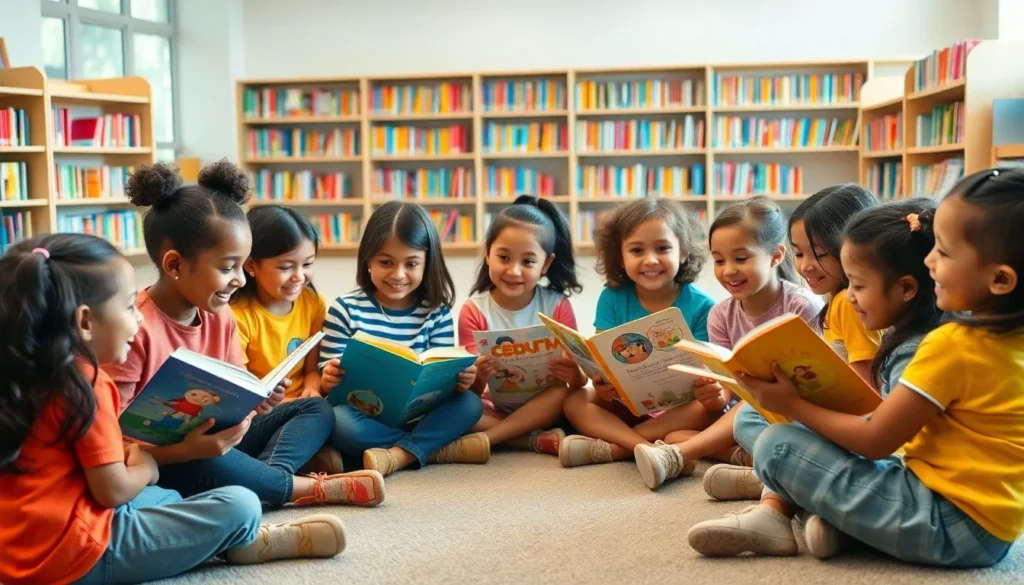Table of Contents
ToggleImagine flipping through a book and discovering that the story unfolds in not just one language but two. Bilingual reading isn’t just a fun twist; it’s a superpower in today’s global world. Whether you’re trying to impress your friends at a dinner party or just want to decode those mysterious signs on your travels, being able to read in multiple languages opens doors you didn’t even know existed.
But it’s not all serious business. Think of bilingual reading as a delightful brain workout. It sharpens cognitive skills and boosts creativity, all while giving you the chance to chuckle at the quirks of language. So grab your favorite bilingual book, and let’s dive into the charming world where words dance in harmony and your reading adventures take on a whole new flair.
Understanding Bilingual Reading
Bilingual reading involves engaging with texts in two languages. This practice enhances language skills and cultural understanding.
Definition and Importance
Bilingual reading refers to the ability to read in two languages. It plays a significant role in today’s globalized society. Being able to interpret texts in different languages fosters communication and cultural exchange. This skill enhances personal connections and enriches travel experiences. Additionally, bilingual reading promotes inclusivity, allowing individuals from diverse backgrounds to share stories and ideas. Incorporating bilingual books into reading habits creates opportunities for enjoyment and learning.
Cognitive Benefits
Bilingual reading offers numerous cognitive benefits. Engaging with multiple languages stimulates brain activity and enhances problem-solving skills. Research indicates that bilingual individuals often exhibit improved multitasking and concentration abilities. Memory retention can increase, as reading in two languages encourages mental flexibility. Moreover, this practice can delay cognitive decline associated with aging. By continuously challenging the brain, bilingual reading enhances overall cognitive development, making it a valuable activity for individuals of all ages.
Strategies for Bilingual Reading

Effective strategies enhance bilingual reading skills. Engaging with texts in two languages provides numerous cognitive benefits.
Phonological Awareness
Phonological awareness involves recognizing sound structures in both languages. This skill supports the development of reading fluency. Practicing with rhymes, songs, and language games improves awareness. Teachers and parents can use interactive activities that emphasize sound patterns. Incorporating these elements into reading sessions can significantly boost engagement and retention.
Vocabulary Development
Vocabulary development is crucial for understanding both written and spoken language. Introducing new words within context aids memory retention and comprehension. Dual-language texts provide rich opportunities for vocabulary expansion. Using visuals and real-life examples complements word learning. Regular discussions about new vocabulary reinforce understanding and encourage usage in various contexts.
Challenges in Bilingual Reading
Bilingual reading presents specific challenges that can affect comprehension and fluency.
Language Interference
Language interference occurs when elements from one language disrupt understanding in another. Reading texts might lead to confusion between vocabulary and grammar rules. For instance, a person may mistakenly apply rules from their dominant language to the second language. This often results in misinterpretation of sentences. Additionally, pronunciation might reflect the phonetic patterns of the first language, affecting reading fluency. Individuals can mitigate these challenges through practice and exposure to diverse texts.
Resource Availability
Resource availability significantly impacts bilingual reading experiences. Finding appropriate bilingual books can be difficult, especially for less commonly spoken languages. Limited access to dual-language resources constricts learners’ opportunities for practice. Schools and libraries may not always offer materials that cater to bilingual readers. Online platforms can help bridge this gap by providing digital resources, but access varies by region. Ensuring adequate materials is crucial for effective bilingual reading development.
Tools and Resources for Bilingual Reading
Bilingual reading requires access to specialized materials and platforms that support this skill. Utilizing the right resources enhances the experience and effectiveness of learning.
Bilingual Books and Materials
Bilingual books offer narratives in two languages side by side, aiding comprehension and vocabulary development. Picture books designed for children often engage young readers with colorful illustrations, making language learning enjoyable. Adult readers benefit from novels that explore cultural themes, providing context for language use. Libraries and independent bookstores frequently stock these resources, but online retailers expand access significantly. Some publishers cater specifically to bilingual audiences, ensuring diverse content is readily available. Engaging with these materials fosters critical thinking and encourages language use in real contexts.
Digital Resources and Apps
Digital resources enhance bilingual reading with interactive features and accessibility options. Language learning apps provide structured lessons that adapt to individual skill levels, helping users practice reading in both languages. Additionally, websites offer dual-language stories, enabling users to toggle between texts for better understanding. Audiobooks developed in bilingual formats facilitate listening skills and reinforce pronunciation. Social media groups and online forums foster community support, allowing readers to share recommendations and experiences, while many platforms integrate games and quizzes that make learning fun. Through these digital tools, users access an abundance of resources to enrich their bilingual reading journey.
Bilingual reading opens doors to a world of opportunities. It enriches personal connections and enhances cognitive skills. By engaging with texts in two languages, individuals not only improve their language abilities but also foster cultural appreciation.
Embracing bilingual literature can transform the reading experience into a fun and rewarding journey. With the right resources and strategies, anyone can overcome challenges and enjoy the benefits of bilingualism. As they explore diverse narratives and expand their vocabulary, readers will find that the advantages extend far beyond language proficiency.







